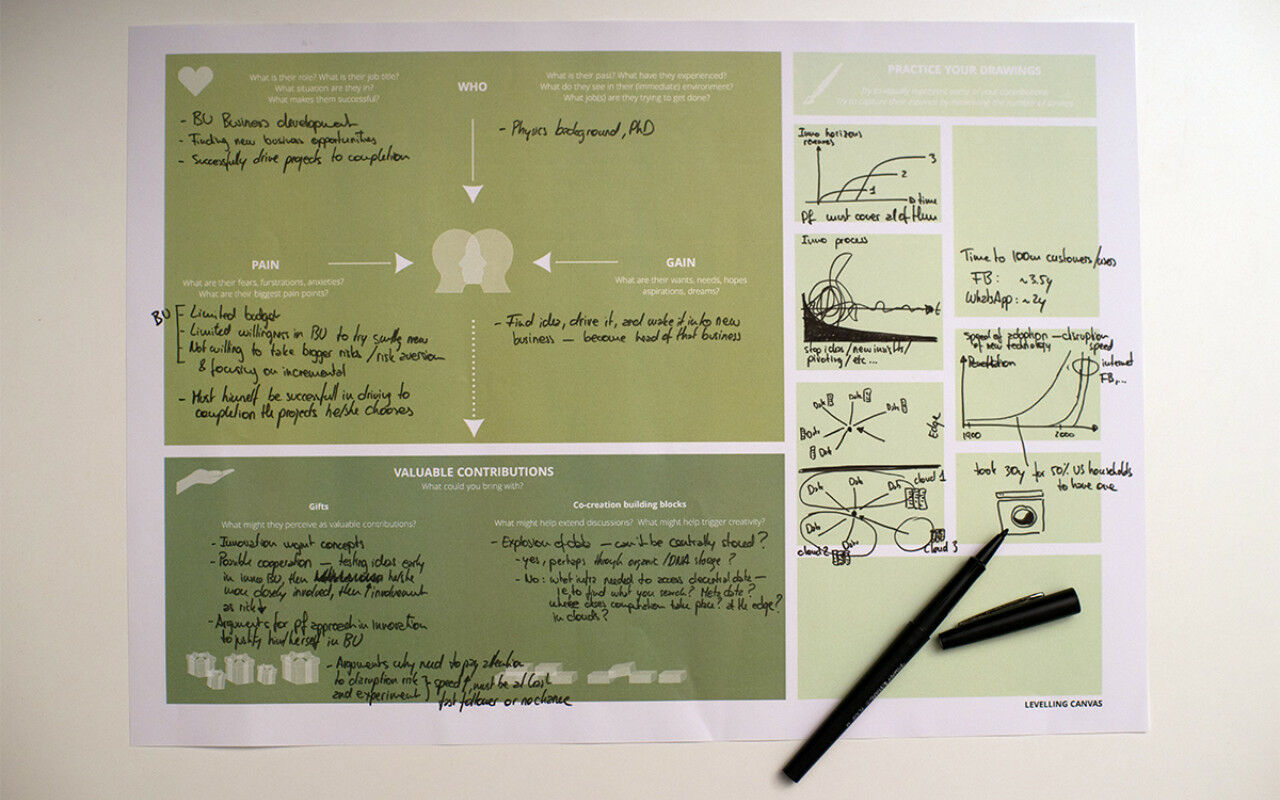A climate of pro-active sharing and co-creation requires a creativity-furthering setting, symmetry/balance in terms of contributions, trust between participants, and transparency.
The method «Levelling» focuses on the element of symmetry/balance by aiming at levelling the playing field in terms of contributions to prevent your counterparty from feeling that they are contributing more. This most notably involves developing a deep understanding of your counterparty (empathy) to anticipate what they might perceive as valuable contributions and what they might contribute themselves.
1. Preparation: Liberating structure
Setting: Think about where the interaction should take place since certain environments are more creativity promoting; try to avoid places that remind them of their daily workload/problems.
Individual brainstorming: Send them some of the topics and/or questions in advance to give them time to think individually (this is especially important with introverts).
Triggers: Don’t bring «perfect» print-outs with you, always draw in the moment because the imperfection of the drawings is more inviting for interaction/contribution.2. Preparation: Empathize
Take the time to put on their shoes: think about their past, potential problems and pain points, and possible dreams/aspirations of your counterparty. Their experience of the interaction and what they will perceive as valuable contributions are driven by both their past and their future.
Think about possible gifts and co-creation building blocks you can bring with. This can include: giving your counterparty a platform to vent; a fun break from their routine tasks; helping them with a personal or professional problem; explaining the broader process/undertaking in which the interaction fits in; sharing information about insights from previous expert interactions, about a new scientific development, or technological breakthrough; sharing thoughts and parallels from other industries; sharing knowledge of methods and conceptual framework (eg, rapid prototyping, double diamond, disruption); sharing an article or book recommendation; explaining your state of factual understanding of the scope of analysis; suggesting the prospect of future benefits (eg, possible involvement if an initiative/project comes out of this interaction). Practice drawing your contributions (see «co-creation» below).
Use the Levelling Canvas to help you prepare – empathizing, thinking about contributions, and practicing your drawings. It is a preparation canvas, do not take it with you as it would bias the interaction. The canvas helps you in making the interaction seem more organic.3. Preparation: Trust
Fact-based preparation: Your counterparty’s time is important, and you must show them that you value it; spend time learning about the subject matter to make them feel their time is not wasted – and to make sure that you will be able to connect/understand the points they are making.
Promises: Always keep your promises - make sure to only make promises you can keep.
Temporal component: Be aware that a single interaction may not suffice for establishing the necessary level of trust.4. Interaction: Transparency
Early in the interaction explain what the background for the meeting is, what the larger process (in which this interaction is embedded) looks like, and how the insights/outputs will be used.
5. Interaction: Sharing
Start sharing at the beginning to show from the outset that both parties will benefit equally during this interaction (promoting a feeling of symmetry) to increase their willingness of pro-active sharing.
6. Interaction: Co-creation
Once you have laid this necessary groundwork, try to reach a state of co-creation with your counterparty because it promotes an even stronger feeling of symmetry (positive feedback loop) and therewith further encourages (pro-active) sharing -- and because it makes the interaction become more than the sum of each one’s creativity.
Use triggers: Share unfinished thoughts to invite others to build on them.
Collective brainstorming: Build on something the other said – not with further questions, but by adding ideas/thoughts of your own to extend their points; avoid being judgmental and use «yes and …» sentences (do not use «yes but …»).
Drawing: continuously draw (on an A3 paper) during the interaction to underline the element of co-creation by externalizing it in tangible form.7. Post-interaction: Reflection
Did you get what you expected out the interaction? Namely, was it successful? Why was it successful? Or why wasn’t it successful? What could you have done better?
Reflect on what you have learnt about your counterparty (re-empathize), about where you were wrong, about what you could have done better, about which contributions were particularly useful and/or perceived as valuable.
Use the Levelling Canvas to help you reflect; re-use the one you used for preparation with a pen of different color to emphasize the differences.8. Post-interaction: Thank you note
Follow-up shortly after the interaction, thank once again for the time, point out something you really appreciated, mention some surprising learnings, remind them of some of your contributions (eg, a link to a book you mentioned), emphasize the co-creation element of the interaction, and join the digitized copy of the drawing from the interaction.
Keep the interaction at 1-to-1 to prevent making it feel too formal and/or overwhelm your counterparty.
- Levelling Canvas
- Thick pen
- A thicker-than-usual A3 paper for the drawing (to emphasize that this interaction is different)



